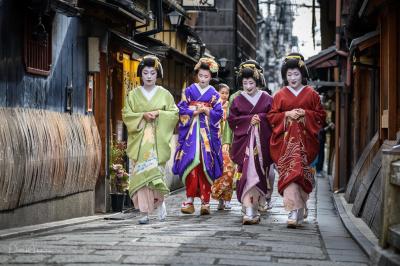Overview
Gion is Kyoto’s geisha district, with hostesses in colorful kimonos often sighted on the wooden Tatsumi Bridge, or amid upscale Japanese restaurants and boutiques on Hanamikoji Street.
Description
Gion is the famous entertainment and geisha quarter on the eastern bank of the Kamo-gawa. While Gion’s true origins were in teahouses catering to weary visitors to the nearby shrine Yasaka-jinja, by the mid-18th century the area was Kyoto’s largest pleasure district. The best way to experience Gion today is with an evening stroll around the atmospheric streets lined with 17th-century traditional restaurants and teahouses lit up with lanterns. Start off on the main street Hanami-kōji, which runs north-south and bisects Shijō-dōri.
At the southern section of Hanami-kōji, many of the restaurants and teahouses are exclusive establishments for geisha entertainment. At the south end, you reach Gion Corner and Gion Kōbu Kaburen-jō Theatre.
If you walk from Shijō-dōri along the northern section of Hanami-kōji and take your third left, you will find yourself on Shimbashi (sometimes called Shirakawa Minami-dōri), which is one of Kyoto’s most beautiful streets, especially in the evening and during cherry-blossom season. A bit further north lies Shinmonzen-dōri and Furumonzen-dōri, running east-west. Wander in either direction along these streets, which are packed with old houses, art galleries, and shops specializing in antiques – but don’t expect flea-market prices.
Gion Corner hosts traditional Kyomai dances, while Kennin-Ji Temple is known for its Zen garden and Yasaka Shrine has seasonal festivals in a lantern-lit courtyard. Nightlife ranges from quiet sake bars to buzzing, pub-like izakayas.
Kyoto
Japan
URL:
http://www.lonelyplanet.com/japan/kansai/kyoto/attractions/gion/a/poi-sig/1231538/356698


